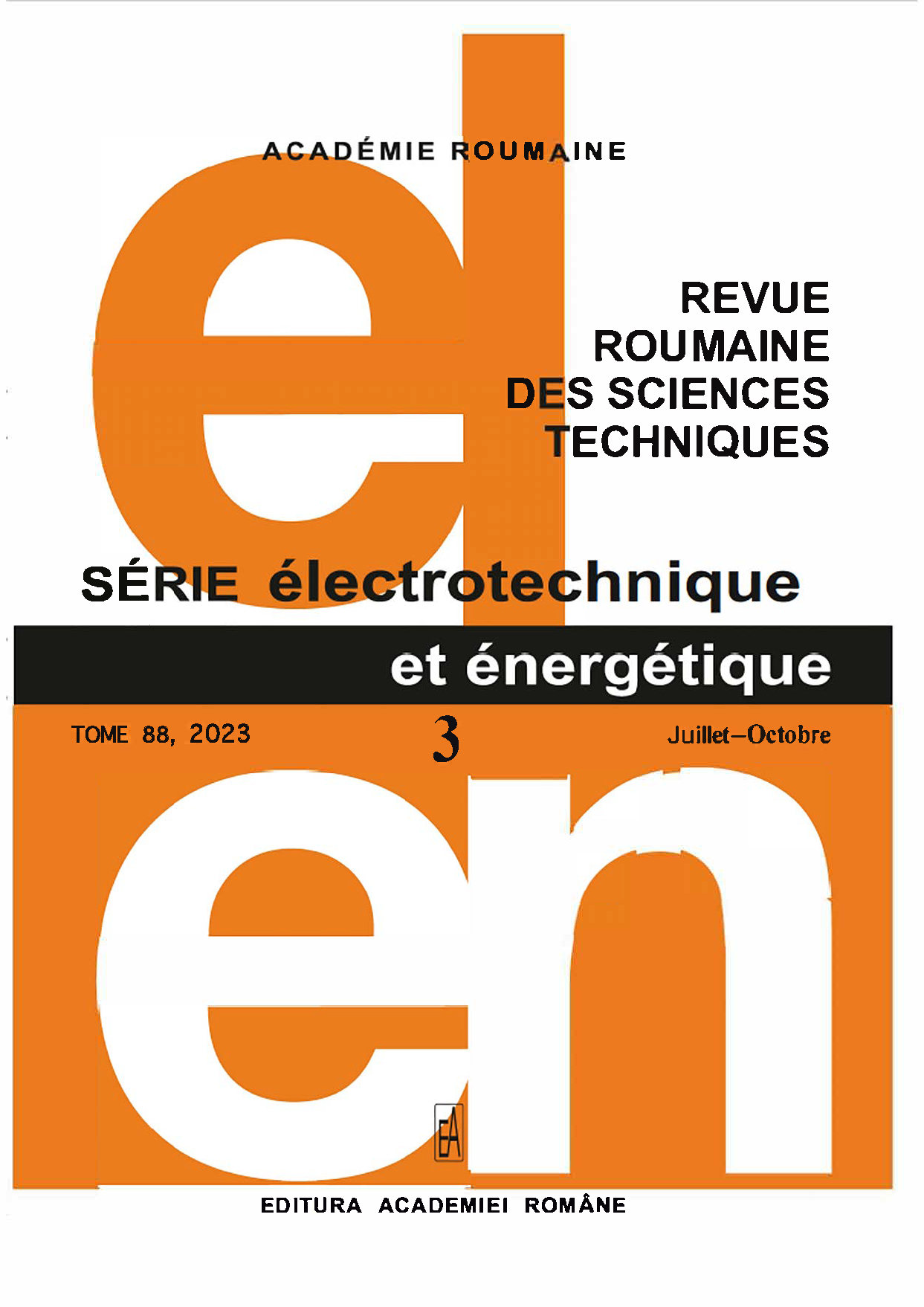ANALYSE D'UN MOTEUR PAS À PAS HYBRIDE BIPHASÉ DE TROIS CENTS DENTS AVEC DIFFÉRENTS NOMBRE DE PAIRES DE PÔLES
DOI :
https://doi.org/10.59277/RRST-EE.2023.3.6Mots-clés :
Moteur pas à pas hybride, Méthode des éléments finis (FEM), Couple de maintien, Couple de détenteRésumé
L'article présente des modèles numériques d'un moteur pas à pas hybride (HSM) biphasé à pas complet de 0,3°, avec 16, 24, 32, 40 et, respectivement, 48 pôles dans le stator. Pour que le moteur se déplace avec un angle de pas constant, le stator et les dents du rotor doivent être décalés l'un par rapport à l'autre avec un angle de zéro, 90, 180 et 270 degrés électriques pour quatre pôles statoriques consécutifs. De ce fait, les moteurs pas à pas biphasés dont le nombre de pôles dans le stator est différent de huit sont à peine visibles. Par conséquent, pour permettre la construction de HSM avec un nombre différent de pôles, certains pôles du stator doivent être décalés de leur position symétrique. Les caractéristiques du couple de détente et de maintien HSM des cinq topologies ainsi que leurs différences géométriques et constructives sont présentées. Les modèles basés sur la méthode des éléments finis (FEM) sont développés à l'aide du logiciel professionnel COMSOL Multiphysics.
Références
(1) P. Li, H. Lu, J.V.V. Athani, Stepper Motors: Fundamentals, Applications and Design, New Age International (1997).
(2) C. Stuebig, B. Ponick, Comparison of calculation methods for hybrid stepping motors, in IEEE Transactions on Industry Applications, 48, 6, pp. 2182–2189 (Nov.-Dec. 2012).
(3) M. Onsal, Y. Demir, M. Aydin, M.K. Guven, Impact of airgap on the performance of 3-phase permanent magnet hybrid stepper motor, IECON 2021 – 47th Annual Conference of the IEEE Industrial Electronics Society, Toronto, ON, Canada, pp. 1–5 (2021).
(4) Ki-Bong Jang, Seong-Yeop Lim, Tae-Bin Lim, Chang-Sung Jin, Yun-Hyeon Cho, Young-Tae Kim, and Ju Lee, Member, IEEE, 2-D FE analysis of hybrid stepping motor using a virtual magnetic barrier, IEEE Transactions on Magnetics, 39, 5 (2003).
(5) E.C.T. So, S.J. Yang, The effect of tooth shape on radial forces in step motors, IEEE Transactions on Magnetics, 29, 6, pp. 2413–2415, (1993).
(6) R.P. Praveen, M.H. Ravichandran, V.T.S. Achari, V.P. Jagathy Raj, G. Madhu, G.R. Bindu, Design and finite element analysis of hybrid stepper motor for spacecraft applications, IEEE International Electric Machines and Drives Conference, pp. 1051–1057 (2009).
(7) I. Ionică, M. Modreanu, A. Morega, C. Boboc, Design and modeling of a hybrid stepper motor, 2017 10th International Symposium on (Advanced Topics in Electrical Engineering (ATEE), Bucharest, Romania, pp. 192–195 (2017).
(8) I. Ionică, M. Modreanu, A. Morega, C. Boboc, Numerical analysis of a hybrid stepper motor for the electromagnetic torque calculation, 2019 11th International Symposium on Advanced Topics in Electrical Engineering (ATEE), Bucharest (2019).
(9) O. Craiu, T.I. Ichim, L. M. Melcescu, L. Popescu, Optimization of a High Torque Density Small Hybrid Stepper using 3D FEM Model, 2022 International Symposium on Power Electronics, Electrical Drives, Automation and Motion (SPEEDAM), pp. 610–615 (2022).
(10) I. Ionică, M. Modreanu, A. Morega, C. Boboc, Geometry Influence on the Electromagnetic Torque Calculation of a Stepper Motor, 2021 12th International Symposium on Advanced Topics in Electrical Engineering (ATEE), pp. 1–7 (2021).
(11) K.R. Rajagopal, B. Sing, B.P. Singh, Optimal tooth-geometry for specific performance requirements of a hybrid stepper motor, in IEEE Transactions on Magnetics, 39, 5, pp. 3010–3012, Sept. 2003.
(12) ***AC/DC Module User’s Guide©, 1998–2020, COMSOL Multiphysics, Version: COMSOL 5.6.
(13) O. Craiu, T.-I. Ichim, L.C. Popescu, 3D fem model of a hybrid stepper using scalar-vector potential formulations, 2023 13th International Symposium on Advanced Topics in Electrical Engineering (ATEE), Bucharest, Romania, pp. 1–5 (2023).
(14) A. Arkkio, Analysis of Induction Motors Based on the Numerical Solution of the Magnetic Field and Circuit Equations, PhD Thesis, Helsinki (1987).
(15) P. Li, H. Lu, J. Shen, Analysis method of dynamic torque-frequency characteristic of hybrid stepping motors, 2017 Twelfth International Conference on Ecological Vehicles and Renewable Energies (EVER), pp. 1–6 (2017).
(16) K.R. Rajagopal, M. Krishnaswamy, B. Sing, B.P. Singh, An improved high-resolution hybrid stepper motor for solar-array drive of Indian remote-sensing satellite, in IEEE Transactions on Industry Applications, 33, 4, pp. 906–913 (1997).
(17) *** https://www.nema.org/standards/view/motors-and-generators
(18) M. Bjekić, A, Milovanovic, B. Koprivica Prediction of pull-in and pull-out torque characteristics of the permanent magnet step motor, Rev. Roum. Sci. Techn. – Électrotechn. Et Énerg.,60, 1, pp. 29–38 (2015).
Téléchargements
Publiée
Numéro
Rubrique
Licence
(c) Copyright REVUE ROUMAINE DES SCIENCES TECHNIQUES — SÉRIE ÉLECTROTECHNIQUE ET ÉNERGÉTIQUE 2023

Ce travail est disponible sous licence Creative Commons Attribution - Pas d'Utilisation Commerciale - Pas de Modification 4.0 International.


